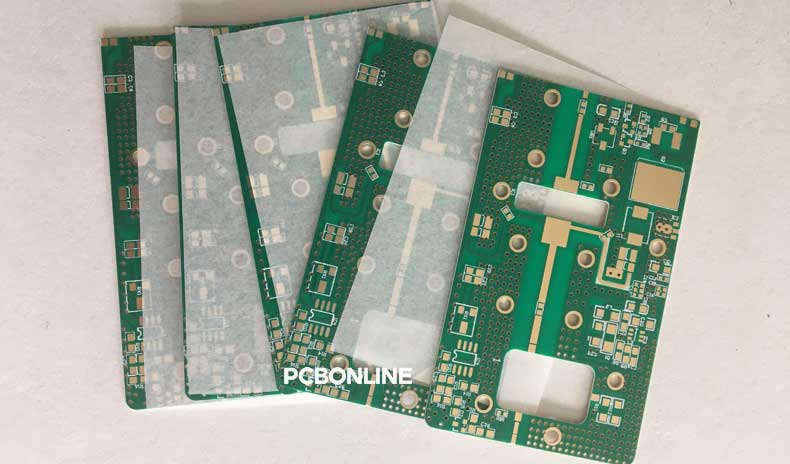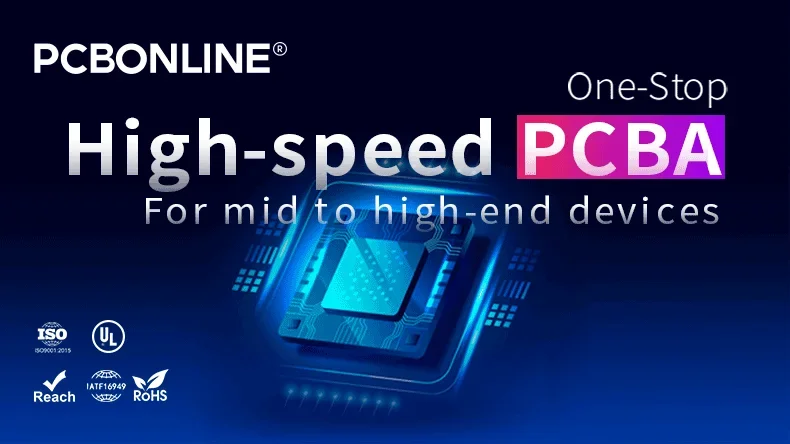PCBONLINE provides Rogers PCBs and FR4 PCBs. However, how about a hybrid stackup of Rogers and FR4? No worries, we also make it. Check a Rogers FR4 PCB below, fabricated by PCBONLINE!

How do we make Rogers and FR4 a hybrid stackup? How is the effect of Rogers FR4 PCB fabrication by PCBONLINE? What are the applications of such an advanced high-frequency PCB? In this article, we will provide a complete guide to the Rogers FR4 hybrid PCB to answer all the questions.
Rogers FR4 PCB Hybrid Stackup
A Rogers/FR4 PCB refers to a high-frequency circuit board using Rogers high-frequency materials (commonly the RO4000 series), modified FR4 laminate materials, and bondply made from multilayer stacking and pressing. The Rogers PCB layers route RF signals, and the FR4 PCB layers route low-frequency signals and power networks.
- Rogers materials, such as RO4350B, RO4003C, RO4835: Feature stable Dielectric Constant (Dk) and extremely low Dissipation Factor (Df), making them suitable for high-frequency/microwave signal layers.
- Modified Low-Dk/Low-Df high-performance FR4 materials, such as Shengyi S1000-2M, Isola 370HR: Characterized by low Dk, low Df, and high thermal resistance, these are used for power planes, control layers, and low-frequency signal layers.
- Bondply, such as Rogers 4450F, RO4450B, and RO3001 Bondply: Functions similarly to the prepreg in FR4, but must offer higher compatibility for hybrid lamination.

Rogers FR4 hybrid PCBs have the advantages of:
- Reduced material costs: Rogers material is expensive, and hybrid lamination can save over 50% in material costs.
- Balanced performance and processability: Rogers is used for RF layers while FR4 is used for power/control layers, ensuring both signal integrity and ease of processing.
- Lightweight and high reliability: Suitable for applications with strict requirements for size, weight, and stability, such as aerospace, satellite, and 5G equipment.
As a one-stop manufacturer of Rogers FR4 hybrid PCBs, PCBONLINE has rich experience in material selection and impedance control. How do we select for Rogers FR4 PCBs?
|
Series
|
Model
|
Dk (10GHz)
|
Df (10GHz)
|
Tg (°C)
|
Features and hybrid compatibility
|
|
RO4000
|
RO4350B
|
3.48
|
0.0037
|
>280
|
Most commonly used hybrid material, easy to process, suitable for multiple lamination cycles, highly compatible with Isola 370HR / TU872.
|
|
RO4000
|
RO4003C
|
3.38
|
0.0027
|
>280
|
Similar to RO4350B, but lower loss; often used in radar and 5G antennas.
|
|
RO4000
|
RO4835
|
3.48
|
0.0037
|
>280
|
Enhanced oxidation resistance, suitable for high-power RF modules.
|
|
RO4000
|
RO4730G3
|
3.00
|
0.0025
|
>280
|
Specifically designed for automotive 77GHz radar antennas; excellent hybrid performance.
|
|
RO4000
|
RO4360G2
|
6.15
|
0.0038
|
>280
|
High-frequency high-power circuits, high-Dk layer for hybrid design with low-Dk layers.
|
|
RO4000 Bondply
|
RO4450F / RO4450B
|
3.52
|
0.004
|
-
|
Hybrid bondply is used for adhering the RO4000 series to FR4 layers.
|
To ensure compatibility between FR4 and Rogers, we select modified FR4 materials that offer low Dk, low Df, and high thermal resistance, as shown below.
|
Brand
|
Material model
|
Dk (1GHz)
|
Df (1GHz)
|
Tg (°C)
|
Features
|
|
Isola
|
370HR
|
4.04
|
0.016
|
180
|
High Tg, low loss, commonly used for RO4350B hybrid stackup.
|
|
Isola
|
I-Speed
|
3.70
|
0.0027
|
185
|
Better Dk match with Rogers.
|
|
Nelco
|
N4000-13EP
|
3.7
|
0.0037
|
180
|
Good high-frequency compatibility.
|
|
TUC
|
TU-872 / TU-883
|
3.9
|
0.0025
|
170
|
Often used in 5G base stations and hybrid structures.
|
|
Panasonic
|
Megtron 6
|
3.6
|
0.0038
|
200
|
Excellent match for RO4003C/RO4835, suitable for high-speed differential signals.
|
|
Shengyi
|
S1000-2M
|
3.8
|
0.004
|
180
|
Domestic high-performance FR4, used for high-speed and RF hybrid.
|
|
Doosan
|
DS-7409D
|
3.7
|
0.004
|
180
|
Medium-to-high frequency compatible, good pressing performance.
|
Common bondply models selected for Rogers FR4 PCBs include Rogers 4450F, RO4450B, RO3001 Bondply, or specialized hybrid-compatible epoxy prepregs such as the Taconic FastRise series.
How about the common stackup of Rogers FR4 PCBs? They are following.
|
Application scenario
|
High-frequency layer
|
Bondply
|
FR4 layer
|
Key features
|
|
5G base station antenna
|
RO4350B
|
RO4450F
|
Isola 370HR / TU872
|
Low insertion loss on RF layers, low cost on FR4 layers.
|
|
Automotive millimeter wave radar
|
RO4730G3
|
RO4450F
|
Megtron 6
|
High RF precision, strong thermal stability.
|
|
Radar antenna feed board
|
RO4003C
|
RO4450B
|
S1000-2M
|
Domestic substitution solution.
|
|
Satellite communication module
|
RO4835
|
RO4450F
|
N4000-13EP
|
Oxidation resistance, low loss.
|
|
RF power amplifier module
|
RO4350B
|
RO4450F
|
FR408HR
|
Low insertion loss, high reliability.
|
How to Make Materials Compatible in a Rogers FR4 PCB?
The core of Rogers FR4 PCB hybrid laminating is to make the Rogers and FR4 materials electrically and thermo-mechanical compatible.
Achieving Electrical Compatibility in Rogers FR4 PCB
To achieve electrical compatibility among different materials in a Rogers FR4 PCB, we must establish impedance matching at FR4 50Ω±5%, and the material selection must ensure that the Dk difference is ≤0.3 and the Df difference is ≤0.010.
For example, if we select Rogers RO4350B (with Rogers FR4Dk = 3.48Rogers FR4 and Rogers FR4Df = 0.0037Rogers FR4), we can choose modified FR4 materials like Megtron 6 (Dk≈3.6) or I-Speed (Dk≈3.7). Furthermore, we must optimize the transition area structure, ensuring high-frequency traces are routed within the Rogers layers and minimizing layer transitions.
As a Rogers FR4 PCB manufacturer, PCBONLINE also ensures:
- Laminated layer thickness tolerance is controlled within ± 5%.
- Precise Dk control during hybrid lamination, with a tolerance controlled within 0.05.
Achieving Thermo-mechanical Compatibility in Rogers FR4 PCB
In a Rogers FR4 PCB, we must ensure that the Rogers and FR4 materials' thermal expansion, glass transition temperature, and water absorption rate are matched. Failure to do so could result in delamination, warping, or cracking during lamination, reflow soldering, or thermal cycling.
What we do includes:
- Selecting high-Tg FR4 (Tg≥ 170°C) and Rogers Tg > 280°C
- Ensuring the CTE (Coefficient of Thermal Expansion) of Rogers and FR4 materials is matched, with the FR4 material's CTE in the Z-direction being less than 70 ppm/°C
- Ensuring the FR4 has a low water absorption rate (≤0.1%) and pre-baking both FR4 and Rogers before PCB production
- Selecting bondply that matches the flow and curing characteristics of the Rogers and FR4 materials.
Applications of Rogers FR4 PCB

Rogers FR4 PCBs are primarily applied in high-end, high-speed, and high-frequency RF domains, including 5G communication, radar, and other fields.
- 5G communication base stations and antenna arrays: RF front-end modules in 5G base stations (antenna array, power amplifier, low-noise amplifier, filter)
- Automotive millimeter-wave radar (77GHz/79GHz): automotive collision-avoidance radar, blind spot detection, automatic parking systems
- Satellite communication and radar systems: low-earth orbit (LEO) communication modules, active electronically scanned array (AESA) radar
- RF front-end modules: power amplifier, low-noise amplifier, and filter
- Aerospace and defense radar systems: high-frequency microwave layers use Rogers RO3006 or RO4350B; power, control, and signal interface layers use high-Tg FR4.
Partner with PCBONLINE for One-stop Rogers FR4 PCBs
If you have a project plan for high-speed or high-frequency applications, whether you have completed the high-frequency PCB design or not, you can work with the one-stop advanced PCB manufacturer PCBONLINE for turnkey PCB manufacturing, including Rogers FR4 PCBs.

Founded in 2005, PCBONLINE has two large advanced PCB manufacturing bases, one PCB assembly factory, stable supply chains, and an R&D team.
Provide one-stop high-speed and high-frequency PCB manufacturing, including R&D, prototyping, PCB fabrication, component sourcing, PCB assembly, PCBA value-added, and box-build assembly.
Minimum laser drill: 0.075mm, minimum mechanical drill: 0.15mm, with microvia structures of 100 µm and 125 µm. High-density circuit layers up to 20, and microvia layers up to 64.
PCBONLINE grasps the core technologies for high-frequency PCB manufacturing, such as impedance control, embedded antenna DFM, expansion/contraction control, etc.
Have ready-to-use high-speed PCB base materials in stock, and the storage period is within 45 days (at manufacturers who have no storage, it usually takes 2 to 3 months to purchase base materials).
Can make various hybrid high-frequency PCBs, including Rogers FR4 PCB and Rogers FR4 ceramic PCB.
High-quality high-frequency PCB manufacturing certified with ISO 9001:2015, ISO 14001:2015, IATF 16949:2016, RoHS, REACH, UL, and IPC-A-600 Class 2/3.
PCBONLINE pays attention to quality and cost-effectiveness in high-speed high-frequency PCBs. If you want to get a quote or ask questions about Rogers FR4 PCBs, you can send emails to info@pcbonline.com to get a quote.
Conclusion
Rogers FR4 PCBs use RO4000 series and modified low-Dk/low-Df FR4 materials with electrical and thermo-mechanical compatibility controls. If you need Rogers FR4 PCBs or PCBA, work with the one-stop high-frequency PCB manufacturer PCBONLINE.
PCB fabrication at PCBONLINE.pdf




